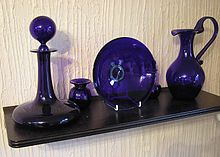Cobalt blue
| Cobalt Blue | |
|---|---|
 A sample of a commercial cobalt blue pigment | |
| Hex triplet | #0047AB |
| sRGBB (r, g, b) | (0, 71, 171) |
| HSV (h, s, v) | (215°, 100%, 67%) |
| CIELChuv (L, C, h) | (33, 82, 259°) |
| Source | [Unsourced] |
| B: Normalized to [0–255] (byte) | |
Cobalt blue is a blue pigment made by sintering cobalt(II) oxide with alumina at 1200 °C. Chemically, cobalt blue pigment is cobalt(II) oxide-aluminium oxide, or cobalt(II) aluminate, CoAl2O4. Cobalt blue is lighter and less intense than the (iron-cyanide based) pigment Prussian blue. It is extremely stable and has historically been used as a coloring agent in ceramics, (especially Chinese porcelain), jewelry, and paint. Transparent glasses are tinted with the silica-based cobalt pigment smalt.
Historical uses and production
Cobalt blue in impure forms had long been used in Chinese porcelain,[1] but it was independently discovered as a pure alumina-based pigment by Louis Jacques Thénard in 1802.[2] Commercial production began in France in 1807. The first recorded use of cobalt blue as a color name in English was in 1777.[3] The leading world manufacturer of cobalt blue in the 19th century was Benjamin Wegner's Norwegian company Blaafarveværket, ("blue colour works" in Dano-Norwegian). Germany was also famous for production, especially the blue colour works (Blaufarbenwerke) in the Ore Mountains of Saxony.
Cobalt blue in human culture



- Watercolorist and astrologer John Varley suggested cobalt blue as a good substitution for ultramarine for painting skies, writing in his "List of Colours" from 1818: "Used as a substitute for Ultramarine in its brightness of colour, and superior when used in skies and other objects, which require even tints; used occasionally in retrieving the brightness of those tines when too heavy, and for tints in drapery, etc. Capable, by its superior brilliancy and contrast, to subdue the brightness of other blues."[4]
- Cobalt blue has been used in paintings since its discovery by Thénard by painters such as Turner, the Impressionists such as Renoir, Monet and Post-Impressionists such as Van Gogh.[5] It is stable and lightfast and also compatible with all other pigments.

Pierre-Auguste Renoir, Boating on the Seine (La Yole), ca 1879 - Maxfield Parrish, famous partly for the intensity of his skyscapes, used cobalt blue, and cobalt blue is sometimes called Parrish blue as a result.
- Cobalt blue was the primary blue pigment used in Chinese blue and white porcelain for centuries, beginning in the late 8th or early 9th century.[6]
- Because of its chemical stability in the presence of alkali, cobalt blue is used as a pigment in blue concrete.
- The blue seen on many glassware pieces is cobalt blue, and it is used widely by artists in many other fields.
- Cobalt glass almost perfectly filters out the bright yellow emission of ionized sodium.
- Cobalt blue is used as a filter used in ophthalmoscopes, and is used to illuminate the cornea of the eye following application of fluorescein dye which is used to detect corneal ulcers and scratches.
- Major League Soccer's Sporting Kansas City have had cobalt blue as the secondary color of its home uniforms since 2008.[7]
- Several countries including the Netherlands and Romania, and a U.S. state - Nevada - have cobalt blue as one of three shades of their flags.
- Sega's official logo color is cobalt blue. Sonic the Hedgehog, Sega's current mascot, was colored to match.[8]
Toxicity
Cobalt blue is toxic when inhaled or ingested. Potters who fail to take adequate precautions when using cobalt blue may succumb to cobalt poisoning.
See also
References
- ^ Kerr, Rose; Wood, Nigel (2004), Science and Civilisation in China Volume 5. Part 12, Ceramic Technology, Cambridge: Cambridge University Press, pp. 658–692, ISBN 0-521-83833-9.
- ^ Gehlen, A.F. (1803). "Ueber die Bereitung einer blauen Farbe aus Kobalt, die eben so schön ist wie Ultramarin. Vom Bürger Thenard". Neues allgemeines Journal der Chemie, Band 2. H. Frölich. German translation from Thénard, L.J. (1803, (Brumaire, XII)), "Considérations générales sur les couleurs, suivies d'un procédé pour préparer une couleur bleue aussi belle que l'outremer" (PDF), Journal des Mines, 86: 128–136
{{citation}}: Check date values in:|year=(help)CS1 maint: year (link). - ^ Maerz and Paul A Dictionary of Color New York:1930 McGraw-Hill Page 91; Color Sample of Cobalt Blue: Page 131 Plate 34 Color Sample L7
- ^ "[1] » J Varley's List of Colours » " The British Museum Collection Online. Accessed 28 May 2014.
- ^ Cobalt blue ColourLex
- ^ "Chinese visual arts » Stylistic and historical development, 1206–1912 » Yüan dynasty (1206–1368) » Ceramics." Encyclopædia Britannica Online. Accessed 14 May 2009.
- ^ "Wizards unveil new look for '08 season," Kansas City Wizards Media Relations, January 20, 2008.
- ^ Sheffield, Brandon. "Out of the Blue: Naoto Ohshima Speaks". Gamasutra. Retrieved 12 August 2013.
Well, he's blue because that's Sega's more-or-less official company color
Further reading
- Roy, A. Cobalt blue, in Artists’ Pigments, Berrie, B.H., Ed., National Gallery of Art Washington, 2007
External links
- "History of Cobalt blue". Pigments through the Ages. WebExhibits.
- Cobalt blue ColourLex

